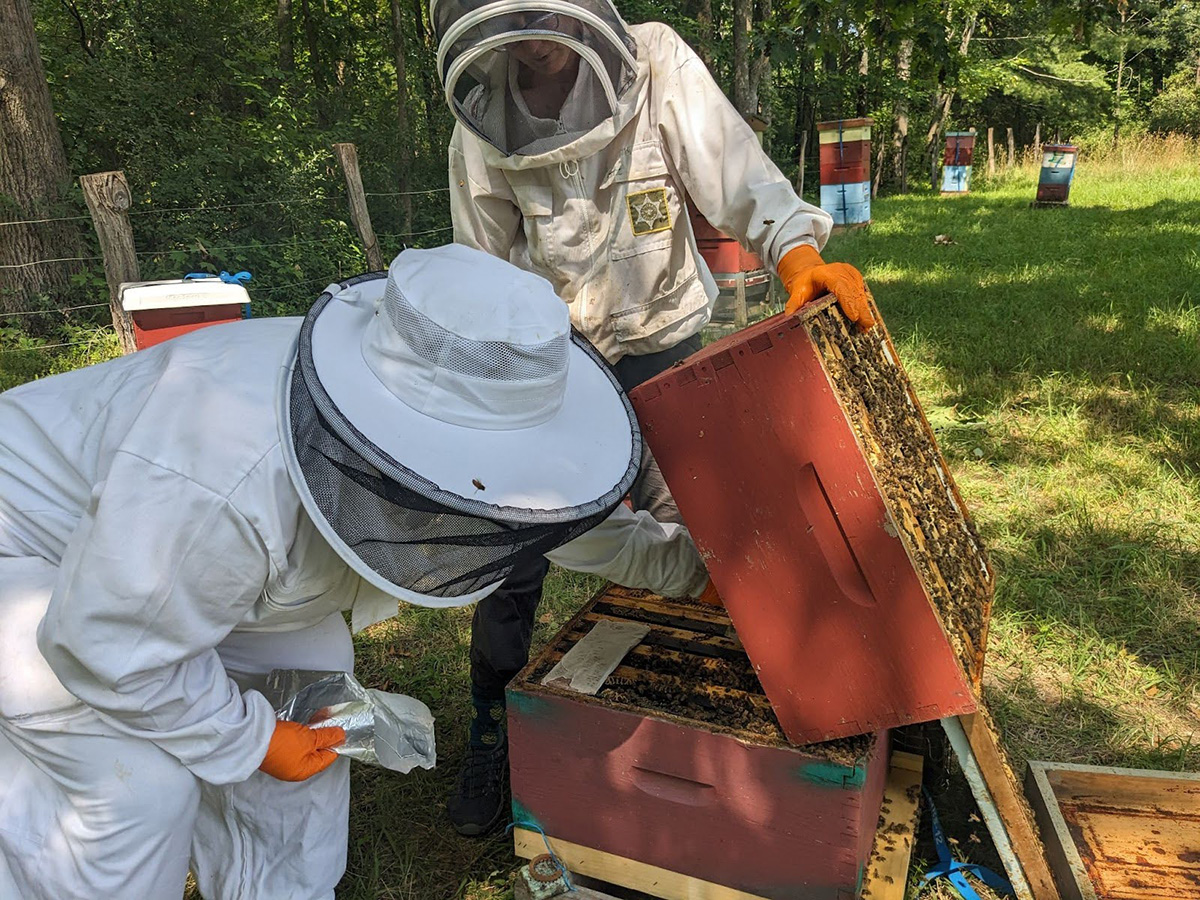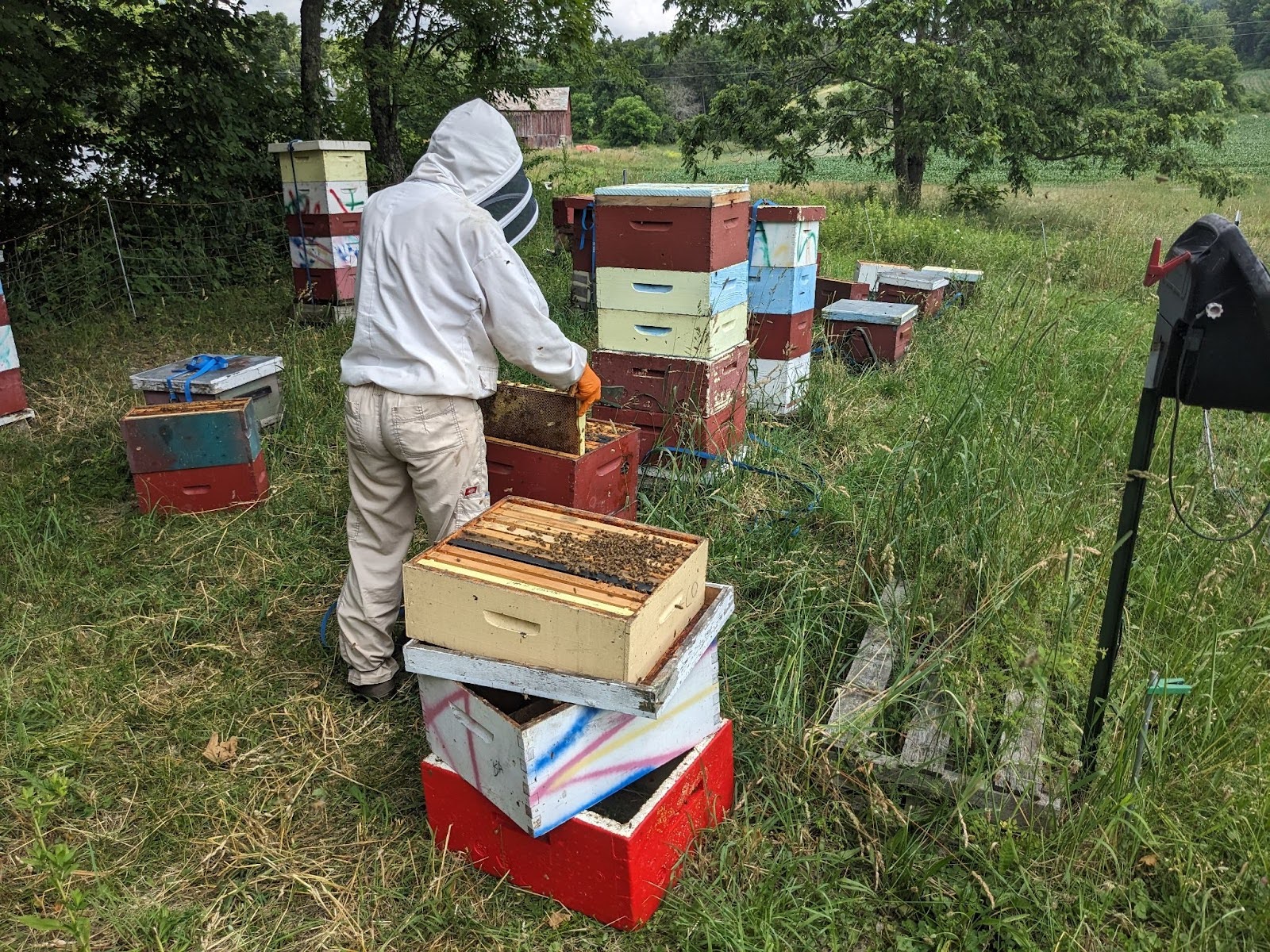This article is adapted from the lecture "Work Smarter, Not Harder," one of the lectures that Betterbee's team of speakers is proud to offer as remote or in-person lectures to bee clubs.
We're close to the end of summer and that means harvest time. Honey is a lovely product when it's in small jars, but before that it's in heavy boxes, then in heavy buckets. If you despair of lifting honey or avoid doing inspections because of the lifting involved, read on to learn ways you can work smarter, not harder.
Honey frames are the heaviest frames in a hive
Of all the materials you find in a hive, honey is the heaviest.
One deep frame full of honey weighs about six and a half pounds. A honey-filled deep frame in a brood box will likely be found by either wall of the hive. After removing it, frames towards the center will get lighter until soon you are inspecting frames full of lightweight brood.
Lifting each frame does get repetitive though, and that can add up to finger, hand, and wrist strain. Here are a few tips to lessen wear and tear on these body parts:
- Use two hands. Two hands placed at each end of the top bar lift far better than one hand using a frame lifter.
- After pulling a frame up, shift your grip to halfway down the side bars. This makes it easier to flip the frame to view the other side. Your thumbs will thank you when they don't need to twist and torque the top bar to flip the whole frame upside down!
- If a frame feels unmanageable as you lift it clear of the box rim, set the frame's bottom bar on the edge of the box for a little rest. You don't need to hold it up when you've got a handy surface to rest it on.
The good news is that aside from honey, most individual frames in a hive aren't that heavy, and there's usually just one heavy honey-filled frame by each wall. But what about when you have to move a whole box?
Consider using shallow boxes as honey supers to lessen the weight of your supers
Most beekeepers use two deeps for the brood chamber and three or four mediums for honey supers. But don't forget shallows! This size box is about half the height of a deep. They're almost forgotten and many folks mistakenly call mediums "shallows" because they've never seen real shallow boxes. But shallows used to be the typical height honey super available for Langstroth hives. This might have been because comb honey was the original and only way to harvest honey. Comb honey was produced and sold as roughly 4-inch sections, so the supers were about that height. Big burly beekeepers may have switched to medium boxes because they didn't mind lifting them, but if they're causing trouble for you there's no reason not to consider shallow boxes instead.
Deep 9-5/8 inches tall, medium 6-5/8 inches tall, shallow 5 3/4 inches
Don't let the weight of full deep hive boxes scare you off
What if you had a deep box filled with honey? The phrase "A deep can weigh 70 lbs" is seen over and over in articles, catalogs, and beekeeping books. That figure is accurate, but it might scare off many potential beekeepers before they even start! But hardly anyone except some commercial beekeepers uses deeps as honey supers. And commercial beekeepers have young helpers and heavy machinery to do most of the lifting!
So besides those few commercial beekeepers, what's the story with that 70 lb. warning? Well, it's true that at the end of the bee year in the fall in the north, the top deep brood box should be full of honey to feed the colony through winter. Wonderful, heavy honey keeps your bees alive all winter as they huddle, nibble, and shiver. But think: there's hardly ever a reason to pick up that top brood box after summer ends. Even during the winter when you do an oxalic acid treatment or check to make sure the bees are still alive, there's no need to lift the box off. And by springtime, if all goes according to plan the bees will have eaten that heavy honey by the time you start lifting boxes again.
Handling honey supers can be a pain
But setting aside 70 lb. deeps, a 50 lb. medium super can still be daunting enough at harvest time. Let's say you need to kill mites in early July, but you plan to harvest in late August. How can you avoid lifting supers off and putting them back on for a midsummer Formic Pro application? Should you just wait and treat in August? (No!!!!)
Sometimes it really is necessary to remove and replace supers, but there are a few ways you can avoid some or all of this lifting during your beekeeping.
Use the tip-up technique to check boxes and frames

An example of the "tip up" method.
Instead of lifting and replacing a super or brood box to get underneath it, try a tip-up. When doing a tip-up, pry up the top box a little from the back to release it from the box and frames below, and scootch it back an inch or so. Then lift the back end, leaving the front end sitting on the lower box. You can see into the box underneath and even add or remove miticides such as Apivar, Hopguard, or Formic Pro. Using the tip-up method and a helper to squirt in the treatment, winter OA dribbles can be done in 2 minutes per hive without any strain. You can't pull frames from under a tipped-up upper box, so this won't solve all of your problems, but it can be a helpful trick to avoid some heavy lifting.
Remove frames from boxes instead of the whole box
Another way to skip the terrible chore of handling heavy supers (sometimes at lofty heights if you had a great honey flow and each hive has many supers stacked up on it), is to change your way of thinking. Why lift a box when each item in the box weighs much less? If you have time and extra empty supers or a spare nuc box, you can remove frames one by one, setting just a few into the empty box. These can be easily set into the pickup truck (parked within feet of the hive, of course). The super, holding the last few frames, can then be pried up and loaded. Instead of one 50 lb box of honey, you can carry 2 or 3 much lighter boxes.
Of course, remember shallow supers! Each shallow of honey weighs about 38 lbs.
Consider the pros and cons of smaller or lighter bee equipment
If you use 10 frame equipment, should you change all your gear to 8 frame boxes? Maybe. But do your math. Switching to 8 frame does reduce weight by about 20%, or the weight of two medium frames. What if you simply took out two frames before handling a 10 frame super? Changing your behavior may be easier than changing your equipment.
| Type of Box |
Weight |
| Empty medium 3/4" thick wood super |
4.65 lbs |
| Empty medium Lyson super |
4.50 lbs |
| Empty medium BeeMax super |
1.90 lbs |
Should you change to polystyrene boxes? Maybe, but do your research. Some polystyrene hive boxes weigh just ounces less than wood, while others are substantially lighter. Of course, full of honey frames, the weight of the box may be pretty insignificant.
Use extra hive boxes to make a "table" on which to rest your full boxes

Anne's temporary table used to avoid putting the heavy box down low.
A good overall way to avoid extra work is to stop setting any boxes down low. If you keep a couple extra deeps in the bee yard, these can be used as a temporary table. Set the boxes on the ground, set the hive's cover on top of them, and then set the supers onto the elevated cover instead of putting them all the way down on the ground. This way, moving boxes off means moving them to the side, not down (and later, up).
Another way to use extra boxes is to replace the need for a stepladder. To deal with the tiny steps on a ladder while holding a super is asking for a twisted joint or a fall. Instead, try making a stable step from a medium or deep with a wooden outer cover set on it. Later the cover and box can become hive parts again.
Fill honey buckets halfway for easier transport, then top off with more honey
So far, we learned how to choose a lighter box, handle heavy frames, and deal with a heavy box. After it's extracted, honey is in buckets, ready to be bottled. Typically, the post-extraction scene looks like this: multiple full buckets gathered on the floor, and one bottling bucket or tank with a honey gate way up on the table or countertop.
What's the best technique to fill or top off the bottling bucket up on the table? I used to lift a full bottling bucket onto a chair, then step on the same chair, then get it up on the counter. I did this for years, then had this life-altering thought: I could lift up a partly filled bucket, then lift another partly filled bucket to top off the other. Partly filled! I was glowing for days.
Why are 5-gallon buckets the standard? That's 60 lbs of honey, plus a 3 lb bucket and lid! Even moving a 5-gallon bucket across the room is horrible. Do you grab the handle with two hands and let it dangle below you as you waddle? Or do you prefer the one-handed grab, with the other arm sticking way out in a futile attempt to counterbalance the pail? Or do you just slide it along the floor?
If you struggle to lift a 5-gallon bucket, then stop filling them to the top. Or, why not move your honey in 2-gallon buckets? Who's to stop you?
Learn from others
Listen to other beekeepers and learn their tricks. Many of the tips in this article came from a "little old lady" beekeeper named Roberta Glatz. Roberta was short, slight, and kept successfully keeping bees into old age because she was smart. She looked at the heavy boxes the tall, young, male beekeepers were hefting and figured she needed a smarter strategy that would work for her. And she found them. Ask beekeepers in your local club if they have any tips or tricks to make the work easier, and some of them may have brilliant insights to share with you that will make your life easier, even if you are a tall, young, male beekeeper!
If you look at all of the tips in this article, you'll find one recurring theme: instead of buying some wonderful gadget to make your life easier, our advice is to change the way you think. There's no law that says you have to move full boxes and can't just move individual frames. Nobody is forcing you to use 5-gallon pails to move our honey. Reject the idea that hive boxes get set down on the ground as an inspection progresses. Cliched though it is, you need to think outside the box!



